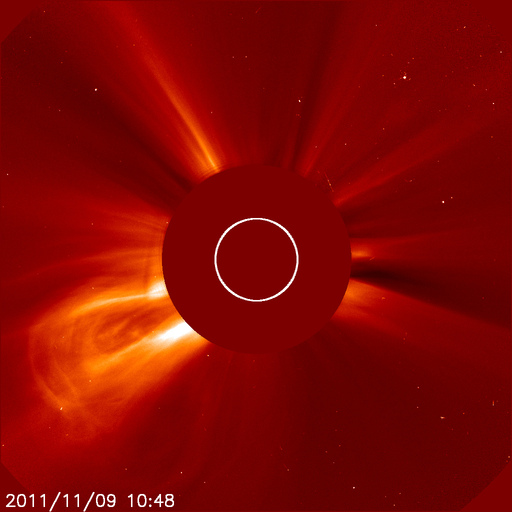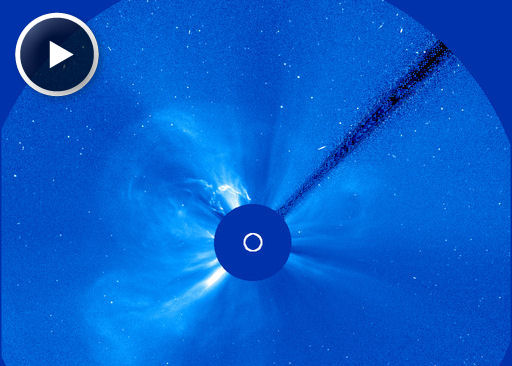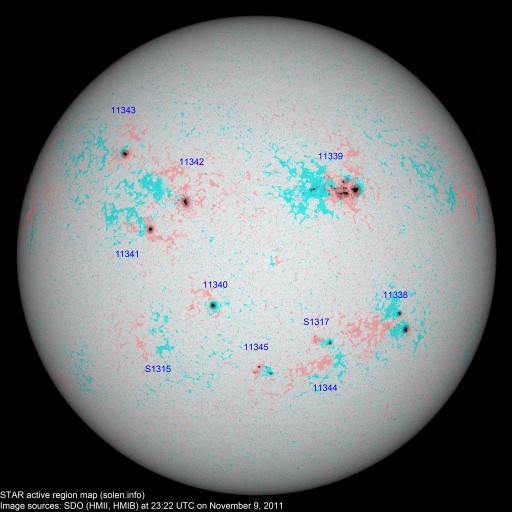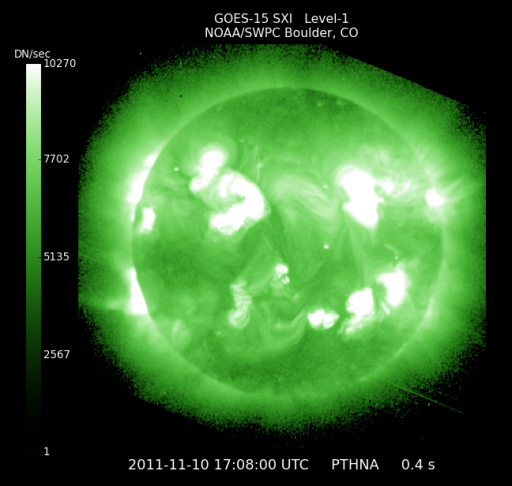Incoming CME

Yesterday, Nov. 9th around 1330 UT, a magnetic filament in the vicinity of sunspot complex 1342-1343 erupted, producing a M1-class solar flare and hurling a CME into space. The Solar and Heliospheric Observatory recorded the progress of the expanding plasma cloud:
Although the eruption was not squarely aimed at Earth, the CME is likely to deliver a glancing blow to our planet’s magnetic field on Nov. 11th or 12th. This could add to the impact of another CME already en route. The earlier cloud was propelled by a filament eruption (movie) on Nov. 7th and is also expected to deliver a glancing blow on Nov. 11th.
Analyses of these events are still preliminary, and the forecast may change. For now it is safe to say that high-latitude sky watchers should be alert for auroras on Nov. 11-12. (SpaceWeather)
Solar wind
speed: 390.9 km/sec
density: 1.1 protons/cm3
The Radio Sun
10.7 cm flux: 180 sfu
Planetary K-index
Now: Kp= 1 quiet
24-hr max: Kp= 1 quiet
Solar Terrestrial Activity Report
The geomagnetic field was quiet on November 9. Solar wind speed ranged between 326 and 407 km/s.
Solar flux measured at 20h UTC on 2.8 GHz was 180.2 (increasing42.6 over the last solar rotation). At midnight UTC the visible solar disk had 10 spotted regions (in 2K resolution SDO images).
New region 11345
November 9: An apparently Earth directed CME was observed after a filament eruption in the northeast quadrant.
A large filament eruption was observed in the southern hemisphere starting at 08:44 UTC in SDO/AIA 193 images. The associated CME does not appear to have any Earth directed component. Another filament eruption was associated with an M1.1 long duration event peaking at 13:35 UTC. This event occurred between regions 11342 and 11343. The associated CME was wide and could reach Earth on November 12.
The geomagnetic field is expected to be quiet on November 10-11. The CME observed on Nov.9 will likely reach Earth on Nov.12 and cause unsettled to minor storm conditions.
Space Weather Message Code: WATA20 (2011 Nov 10 1707 UTC) by SWPC:
WATCH: Geomagnetic A-index of 20 or greater predicted
NOAA Scale: Periods reaching the G1 (Minor) Level Likely
Valid for UTC Day: 2011 Nov 12
The official Sunspot number count for Nov 9, 2011 is listed as 220. This is a new record for Solar Cycle 24.




Commenting rules and guidelines
We value the thoughts and opinions of our readers and welcome healthy discussions on our website. In order to maintain a respectful and positive community, we ask that all commenters follow these rules.